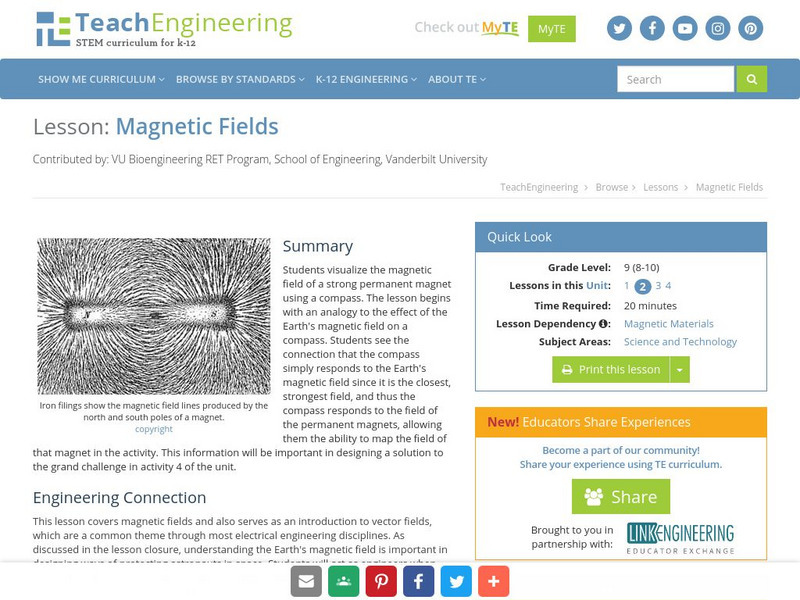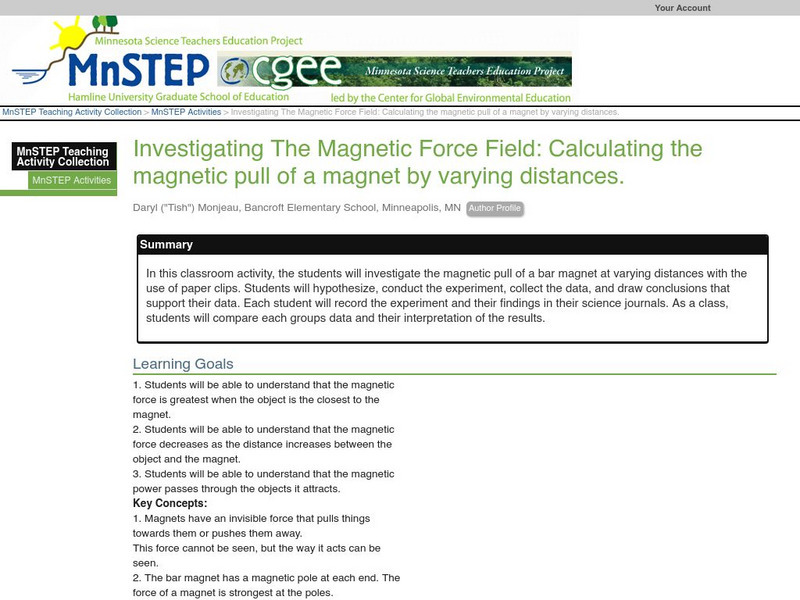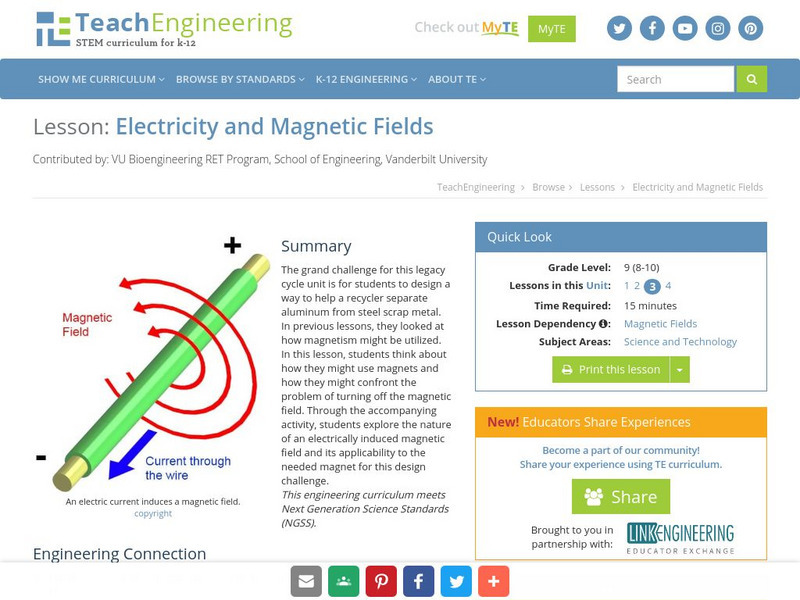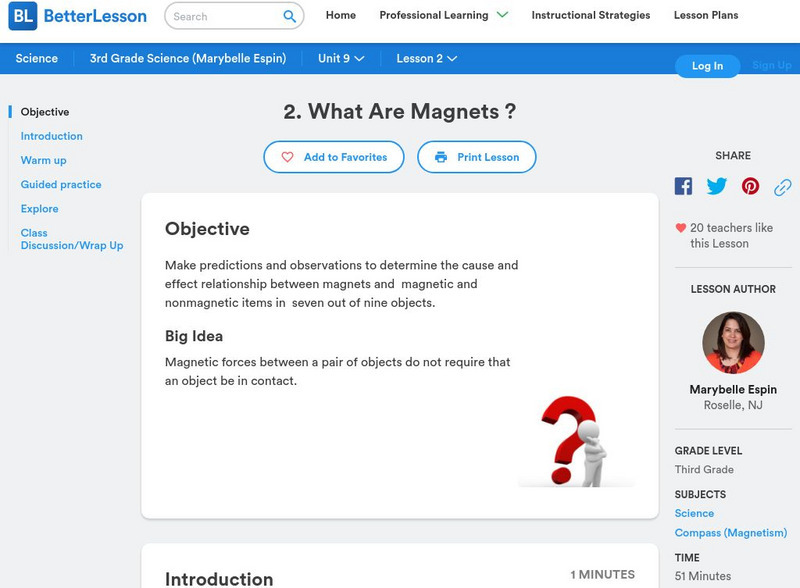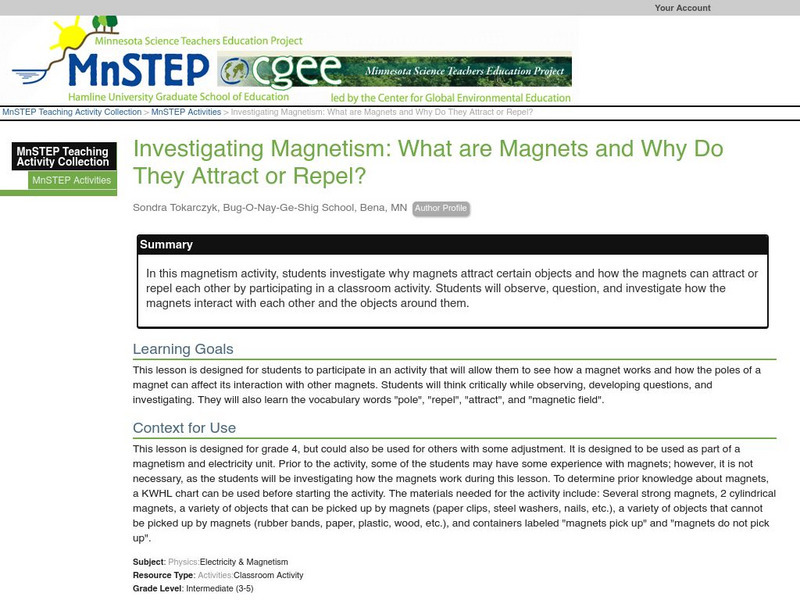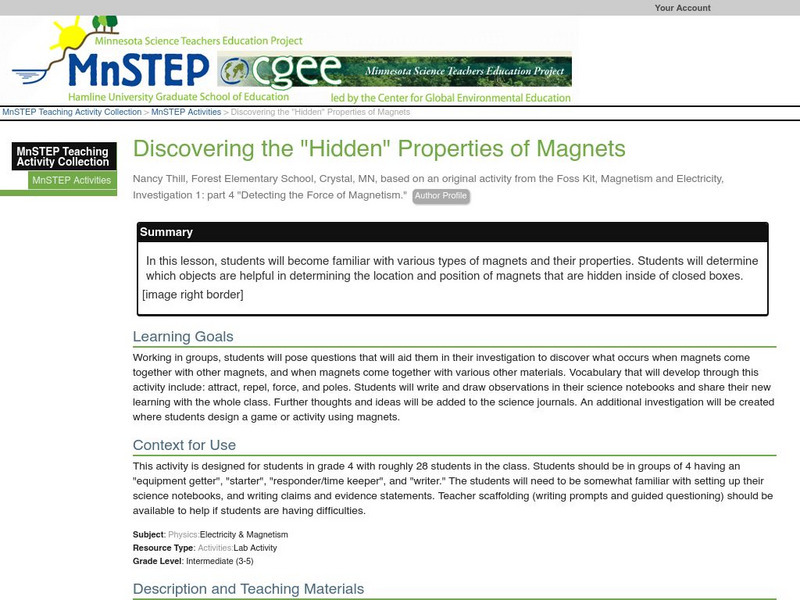Hi, what do you want to do?
TeachEngineering
Teach Engineering: Magnetic Fields
Students visualize the magnetic field of a strong permanent magnet using a compass. The lesson begins with an analogy to the effect of the Earth's magnetic field on a compass. Students see the connection that the compass simply responds...
TeachEngineering
Teach Engineering: Magnetic Fields Matter
This lesson introduces students to the effects of magnetic fields in matter addressing permanent magnets, diamagnetism, paramagnetism, ferromagnetism, and magnetization. First students must compare the magnetic field of a solenoid to the...
Science Education Resource Center at Carleton College
Serc: Investigating the Magnetic Force Field: Calculating Magnetic Pull
In this classroom activity, the students will investigate the magnetic pull of a bar magnet at varying distances with the use of paper clips. Students will hypothesize, conduct the experiment, collect the data, and draw conclusions that...
TeachEngineering
Teach Engineering: Electricity and Magnetic Fields
The grand challenge for this legacy cycle unit is for students to design a way to help a recycler separate aluminum from steel scrap metal. In previous lessons, they have looked at how magnetism might be utilized. In this lesson,...
Science Education Resource Center at Carleton College
Serc: Investigating Magnetism
In this physical science lab, students will investigate ways to control an electromagnet, how adding coils of wire can change the magnet, and the differences between an electromagnet and a bar magnet. Students will explain in their...
University Corporation for Atmospheric Research
Ucar: The Sun Earth Connection: The Magnetic Sun
Students will build a simple version of a magnetometer and use it to discover the types of areas of the Sun that have very strong magnetic fields. Students will then describe what the types of features associated with the Sun's strongest...
TeachEngineering
Teach Engineering: The Electric and Magnetic Personalities of Mr. Maxwell
Students are briefly introduced to Maxwell's equations and their significance to phenomena associated with electricity and magnetism. Basic concepts such as current, electricity and field lines are covered and reinforced. Through...
TeachEngineering
Teach Engineering: Magnetic Materials
Students begin working on the grand challenge of the unit by thinking about the nature of metals and quick, cost-effective means of separating different metals, especially steel. They arrive at the idea, with the help of input from...
The Wonder of Science
The Wonder of Science: 3 Ps2 4: Magnetic Design Solution
See work samples, phenomena, and assessment templates that directly address standard 3-PS2-4: designing a magnetic solution.
PBS
Pbs Learning Media: Magnets!
Learn about magnets, magnetic forces, and how magnets make things move.
University Corporation for Atmospheric Research
Ucar: Planet Magnet
Learners use iron filings to explore the magnetic field around a magnet and record their observations then apply their experience with the magnet to understand the magnetic field around Earth.
American Geosciences Institute
American Geosciences Institute: Earth Science Week: Magnets at the Core
Students simulate magnetic pole reversal to study the movement of Earth's magnetic poles.
Better Lesson
Better Lesson: 2. What Are Magnets ?
Make predictions and observations to determine the cause and effect relationship between magnets and magnetic and nonmagnetic items in seven out of nine objects.
Better Lesson
Better Lesson: Magnetism Exploration
Third graders will be able to identify objects that are attracted or repelled by magnetism.
Better Lesson
Better Lesson: Magnet Engineering Design Challenge
Use the engineering design process to create a solution to problem involving magnets?
ArtsNow
Arts Now Learning: Magnetic Pollack [Pdf]
In this lesson, 5th graders will create a painting based on the action paintings by Jackson Pollock. Instead of dripping and splattering, the paint will be moved using a metal object, such as a paper clip, along with a magnet.
Science Education Resource Center at Carleton College
Serc: Investigating Magnetism: What Are Magnets and Why Do They Attract or Repel
For this magnetism activity, students investigate why magnets attract certain objects and how the magnets can attract or repel each other by participating in a classroom activity. Students will observe, question, and investigate how the...
Alabama Learning Exchange
Alex: The Magnetic Maglev Train
This is a hands-on, inquiry-based lesson plan that includes three magnetic stations in which young scholars or small groups rotate in order to test and discover different magnetic properties and then use their knowledge to build a Maglev...
University Corporation for Atmospheric Research
Ucar: The Sun Earth Connection: Planet Magnet
Hands-on activities help students develop an understanding of Earth's magnetic field. Students use iron filings to explore the magnetic field around a magnet, record their observations, then apply their experience with the magnet to...
Science Education Resource Center at Carleton College
Serc: Exploring Magnetism: Investigating the Forces of Magnets
Learners describe and create an experiment to prove that like poles of magnets repel each other while opposite poles attract. Using the experiment, they use the data to support the claim that the repelling force is stronger than the...
Science Education Resource Center at Carleton College
Serc: Investigating Motors and Magnetism
Learners will build a simple DC motor out of metal coat hangers, a 24-guage wire armature and field magnet, 14-guage wire brushes, and build the motor so that it rotates when connected to a 10-volt DC power supply. Students will...
Science Education Resource Center at Carleton College
Serc: Magnets: What "Sticks"
While working in small groups, students will learn about magnetism by exploring what does and does not "stick" to a manget. Students will learn that only objects made of metal stick to magnets but not all objects made of metal stick.
Science Education Resource Center at Carleton College
Serc: Magnetism and Sound: Creating Your Own Headphones
Students will explore how magnets can create a current by making their own headphones and listening to music from their iPods.
Science Education Resource Center at Carleton College
Serc: Discovering the Hidden Properties of Magnets
In this instructional activity, students determine which objects are helpful in determining the location and position of magnets that are hidden inside of closed boxes.
Other popular searches
- Electricity and Magnetism
- Magnetism Worksheets
- Magnets and Magnetism
- Gravity and Magnetism
- Electricity Magnetism
- Magnetism and Poles
- Induced Magnetism
- Science, Magnetism
- Bill Nye Magnetism
- Science Magnetism
- Magnetism Lesson Plans
- Energy and Magnetism





